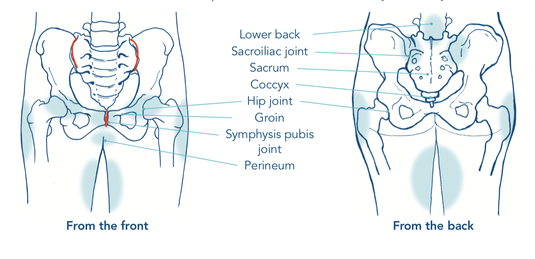What is pelvic girdle pain?Pelvic Girdle Pain (PGP) affects 1 in 5 pregnant women during and/or after pregnancy. The pain is most commonly felt at the front of the pelvis, in the lower back or hips. It can affect movement such as standing, walking and climbing stairs. The Pelvic girdle is the ring of bones which sits at the bottom of the spine, connecting your legs to your spine. It is made up of 3 joints (below in red) which are heavily supported by muscles and ligaments. These muscles and ligaments work together to provide stability in the pelvis but are not rigid and allow some passive movement. Pelvic girdle pain and pregnancyAs a women progresses through her pregnancy the body changes and adapts to the increasing size and weight of the growing baby. This change can cause her posture and pelvic position to change in all postural positions, affecting her load distribution and consequently increasing the load transfer through her joints. The surge in hormones that she experiences from the beginning of the pregnancy contains a hormone called relaxin. This hormone helps to prepare the pelvis for the birth by allowing some laxity to the ligaments, allowing the pelvic opening to expand. However, this change in ligament tension will change the way the body is able to cope with the forces that transfer through each joint and increased support will be saught from the local muscular system. THE SYMPTOMSThe symptoms can range from intermittent and irritating to constant, wearing and distressing. Fear not though, they are very treatable at any stage of pregnancy or post pregnancy. These symptoms can include but are not exclusive to the following:
Risk factors which may increase your chance of getting PGP during pregnancyNot all women who get PGP have identifiable risk factors but these physical risks may apply:
What you can do to help your painOne of the best research-based treatment forms and preventative measure is EXERCISE. Keeping active and moving in a pain free way through pregnancy can help keep the muscles around the pelvis strong and by keeping them strong they can help reduce the forces that are put through your joints. Other tips for reducing pain:
Physiotherapy can offer a postural assessment to find out where the pain is originating from and what can be done to help reduce it. You will be given tailored treatment plan including manual therapy, advice and a specific exercise program tailored for you. Crutches can also be a very helpful addition to help reduce the load that is transferred through the pelvis when walking. Your physio can make sure these are set to the correct height so that you don’t develop further upper back or shoulder pain from using them incorrectly. Will the pain increase in Labour and during the birth? A lot of women with PGP worry that it will worsen through labour, however this is not usually the case.
During Labour, use gravity to help the baby move downwards. Kneeling, on all-fours and standing are good positions to help with this. Try to avoid lying on your back or in a slumped position during labour as this will reduce the pelvic opening and may slow progression. You will also want to avoid putting your feet on a midwife’s or a partner’s hips when pushing to deliver as this may put too much strain on your pelvic joints and may make pain worse. For internal examination you may also be able to ask to lie on your side. Pelvic Girdle Pain resolves in most women once they give birth but in some women it can continue. Read the next blog post for the info on postnatal PGP.
1 Comment
|
AuthorWrite something about yourself. No need to be fancy, just an overview. ArchivesCategories |


 RSS Feed
RSS Feed
